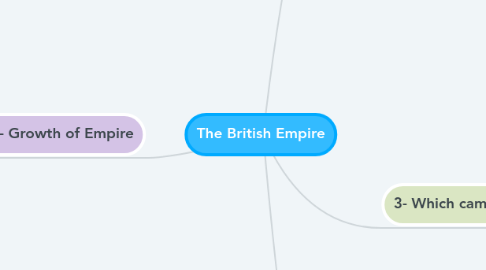
1. 2- Growth of Empire
1.1. By the end of the Napoleonic war, the scenario had been transformed
1.1.1. Population Growht (by 1815 the British population totalled 12 million)
1.1.2. Economy
1.1.2.1. Industraliase
1.1.2.1.1. Agricultural productivity
1.1.2.1.2. Proto-industrialisation
1.1.2.1.3. The growth of manufacturing
1.1.2.1.4. New mineral technologies, along with the arrival of factories
1.1.3. Dual occupations had largely been superseded by specialised, regular working conditions.
1.1.4. Trade and colonisation had also proceeded apace
1.2. During the 18th century British overseas trade became 'Americanised'
1.3. The British became the largest and most efficient carriers of slaves to the New World.
1.3.1. Jamaica, the largest British slave colony, was also the wealthiest colony in the British
1.4. By 1775 Britain possessed far more land and people in the Americas than either the Dutch or the French
1.4.1. The two main northern European rivals for international power and prestige
1.5. Britain recovered swiftly from the loss of the thirteen mainland American colonies in the War of Independence
1.5.1. Britain acquired additional territories during the long war years with France from 1793 to 1815.
1.6. By 1815, Britain possessed a global empire that was hugely impressive in scale, and stronger in both the Atlantic and Indian Oceans
1.6.1. Free trade
2. 1- A florishing Power
2.1. 18th century
2.1.1. Britain
2.1.1.1. Dominant position among European trading empires
2.1.1.2. Became the first Western Nation to industrialise
2.2. The extent of economic change between 1688 - 1815
2.3. English society contained a flourishing and more extensive middling sector than any other western country, including the Dutch Republic.
2.3.1. This provided a strong platform for commerce with, and settlement in, far-flung territories.
2.4. Merchants sent out ships to trade with North America and the West Indies, where England had established a network of colonies
2.4.1. Merchants sent out ships to trade with North America and the West Indies, where England had established a network of colonies
2.5. The triangular slave trade had begun to supply these Atlantic colonies with unfree African labour, for work on tobacco, rice and sugar plantations
2.6. Overseas commerce was conducted within the mercantilist framework of the Navigation Acts
2.6.1. It stipulated that all commodity trade should take place in British ships, manned by British seamen, trading between British ports and those within the empire
2.7. In 1688 Britain was still a vulnerable competitor for stakes in overseas colonies and trade
3. 3- Which came first?
3.1. Trade and Empire went hand in hand with a symbiotic relationship to each other
3.1.1. Growing overseas commerce with colonies stimulated merchants to provide ships, as well as goods for expanding settler societies.
3.1.2. The slave trade also became a vehicle for establishing an empire of slavery in the Caribbean and southern American colonies
3.1.3. Rapid population growth in 18th-century North America provided a large market for British exportsm
3.1.4. A range of metalware and hardware
3.1.4.1. Fabricated to meet the demands of a burgeoning colonial population with less advanced industrial processes than were current in the home country
3.1.5. An integrated Atlantic economy came into being after the mid-18th century
3.1.5.1. In which merchants in British, American, West Indian and Iberian ports established firm commercial ties and a modern, enterprising outlook with regard to making money through imperial trade
4. 4- The Impact of Imperial Trade
4.1. A more positive assessment can be made
4.2. Revenue from slavery and the slave trade filtered back into the British economy in indirect ways
4.2.1. Bankers, insurance specialist and country gentlemen = active investors
4.3. Trade and Empire gave a significant boost to the proliferation and sophistication of financial servicies
4.3.1. Considerable benefit to the long-term development of the British Economy
4.4. How important was that impact?
4.4.1. The current consensus is that trade and empire were significant for British economic growth in the Hanoverian period
4.4.2. "British hegemony in empire and trade by 1815 was such that Britannia did rule the waves..."
4.4.3. The important ability of the British government to raise taxes and loans to support aggressive military policies by Hanoverian governments, and the superiority of the Royal Navy over other European navies,
